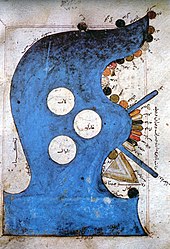This article needs additional citations for verification. (April 2011) |
Abu Ishaq Ibrahim ibn Muhammad al-Farisi al-Istakhri (آبو إسحاق إبراهيم بن محمد الفارسي الإصطخري) (also Estakhri, Persian: استخری, i.e. from the Iranian city of Istakhr, b. - d. 346 AH/AD 957)[2] was a 10th-century travel author and Islamic geographer who wrote valuable accounts in Arabic of the many Muslim territories he visited during the Abbasid era of the Islamic Golden Age. There is no consensus regarding his origin. Some sources describe him as Persian,[1] while others state he was Arab.[3][4] The Encyclopedia Iranica states: "Biographical data are very meager. From his nesbas (attributive names) he appears to have been a native of Eṣṭaḵr in Fārs, but it is not known whether he was Persian".[5]
Abū Ishāk al-Fārisī al-Iṣṭakhrī | |
|---|---|
| Born | |
| Died | died after 952[1] |
| Academic background | |
| Influences | Al-Balkhi |
| Academic work | |
| Era | Islamic Golden Age |
| School or tradition | Balkhi school |
| Main interests | Islamic geography |



Istakhri's account of windmills is the earliest known. Istakhri met the celebrated traveller-geographer Ibn Hawqal, while travelling, and Ibn Hawqal incorporated the work of Istakhri in his book Kitab al-Surat al-Ard.[4][5]
Works
editIstakhri's two surviving works are:
- Masālik al-Mamālik (مسالك الممالك, Routes of the Realms), or Kitab al-masalik wa-l-mamalik (كتاب المسالك والممالك Book of Roads and Kingdoms), a contribution to the "Book of Roads and Kingdoms" tradition. This combines maps with descriptive text to describe the geography of Iran and surrounding kingdoms. It is based mainly on lists of stations of postal routes, and seems intended to help commit those lists to memory rather than to guide travellers through the territory. There is no consistency between the map projections. An illuminated manuscript (MS Or. 3101) dated AH 589 (AD 1193) is held by Leiden University Libraries and is digitally available.[6] Another illuminated manuscript dated AH 706 (AD 1306-07) now resides in the Khalili Collection of Islamic Art. It contains many maps, though some mentioned in the text are missing.[7]
- Ṣuwar al-ʿAqālīm ( صور الاقاليم, Pictures of the Regions).
Published editions
editAn 8-volume edition of works by medieval Arab geographers, edited by the Dutch orientalist Michael Jan de Goeje in a series titled Bibliotheca geographorum Arabicorum was published by Brill, Lugduni-Batavora (Leiden) in the 1870s. An edition of Istakhri's MS text was produced for the first volume under the Latin title Viae Regnorum descriptio ditionis Moslemicae - "Description of Roads of the Kingdoms in Muslim territories". In 1927, the editor Theodore Noldeke produced a second edition.
In 1845, the German orientalist A. D. Mordtmann published a translation in Hamburg with the title Das Buch der Länder von Schech Ebu Ishak el Farsi el Isztachri, with a foreword by C. Ritter. (Schriften der Akademie von Ham Bd. 1, Abth. 2).
See also
editReferences
edit- ^ a b c d Shboul, Ahmad M. H. (1991). "Iṣṭakhrī, al-". In Kazhdan, Alexander (ed.). The Oxford Dictionary of Byzantium. Oxford and New York: Oxford University Press. ISBN 0-19-504652-8.
- ^ Mojtahed-Zadeh, Pirous. "The Persian Gulf in the Geographical Views of the Ancient World" In Cartographie Historique du Golfe Persique. Edited by M. Taleghani, D. Silva Couto, & J.-L. Bacque-Grammont. Louvain, Belgium: Diffusion, 2006. 17.
- ^ van Donzel, E.J., ed. (1994). Islamic Desk Reference (compiled from the Encyclopedia of Islam). Brill. p. 177. ISBN 978-9004097384.
- ^ a b Miquel, André (1954–2005). "Iṣṭakhrī, Abū Isḥāḳ Ibrāhīm". In Gibb, H. A. R.; Kramers, J. H.; Lévi-Provençal, E.; Schacht, J. (eds.). Encyclopaedia of Islam (2nd ed.). Leiden: Brill. IV:222b-223b.
- ^ a b Bolshakov, O. G. (1998). "Eṣṭaḵrī, Abū Esḥāq Ebrāhīm". In Yarshater, Ehsan (ed.). Encyclopædia Iranica. New York: Encyclopædia Iranica Foundation, Inc. VIII(6):646-647 (I have used the updated online version).
- ^ "Digital version of An abridgement of Kitāb al-masālik wa-al-mamālik by Abū Isḥāq Ibrāhīm b. Muḥammad al-Iṣṭaḵrī - Or. 3101". Leiden University Libraries. Retrieved 2024-04-10.
- ^ Rogers, J. M. (2008). The arts of Islam : treasures from the Nasser D. Khalili collection (Revised and expanded ed.). Abu Dhabi: Tourism Development & Investment Company (TDIC). p. 167. OCLC 455121277.
Sources
edit- Bolshakov, O. G. (1998). "EṢṬAḴRĪ, ABŪ ESḤĀQ EBRĀHĪM". Encyclopaedia Iranica, Vol. VIII, Fasc. 6. pp. 646–647.
- Bosworth, Clifford Edmund (1989). "al-Masālik wa'l-Mamālik". The Encyclopedia of Islam, Volume 6. Leiden: E. J. Brill. pp. 639-640.
- de Goeje, M.J., ed. (1927). Bibliotheca Geographorum Arabicorum (1927), vol 1: Viae Regnorum descriptio ditionis Moslemicae auctore Abu Ishák al-Fárisí al-Istakhrí (in Arabic). Leden: E. J. Brill.
- Ouseley, William, ed. (1800). The oriental geography of Ebn Haukal, an Arabian traveller of the tenth century. London. - Note: in fact, it is a work by Istakhri
- Al-Istakhri, Abu Ishaq Ibrahim ibn Muhammad (1927), Goeje, M. J. de; Noldeke, Theodore (eds.), "Viae Regnorum descriptio ditionis Moslemicae auctore Abū Ishāk al-Fārisi al-Istakhri", Bibliotheca Geographorum Arabicorum (in Arabic and Latin), 1 (2 ed.), Lugdunum Batavorum (Leiden): Brill publishers
- Ibn Haukal (1873), Goeje, M. J. de (ed.), "Viae et regna, descriptio ditionis moslemicae auctore Abu'l-Kasim Ibn Haukal", Bibliotheca Geographorum Arabicorum (in Arabic and Latin), 2, Lugdunum Batavorum (Leiden): Brill publishers
- Goeje, M. J. de, ed. (1870), "Indices, glossarium et addenda et emendanda ad Part I-III", Bibliotheca Geographorum Arabicorum (in Arabic and Latin), 4, Lugdunum Batavorum (Leiden): Brill
- Das Buch der Länder von Schech Ebu Ishak el Farsi el Isztachri, translated by Mordtmann, Andreas David, Frankfurt/M.: Rauhen Hauses in Horn, 1995 [1845]
External links
edit- Media related to Estakhri at Wikimedia Commons
- World Map of al-Istakhri Archived 2011-05-14 at the Wayback Machine